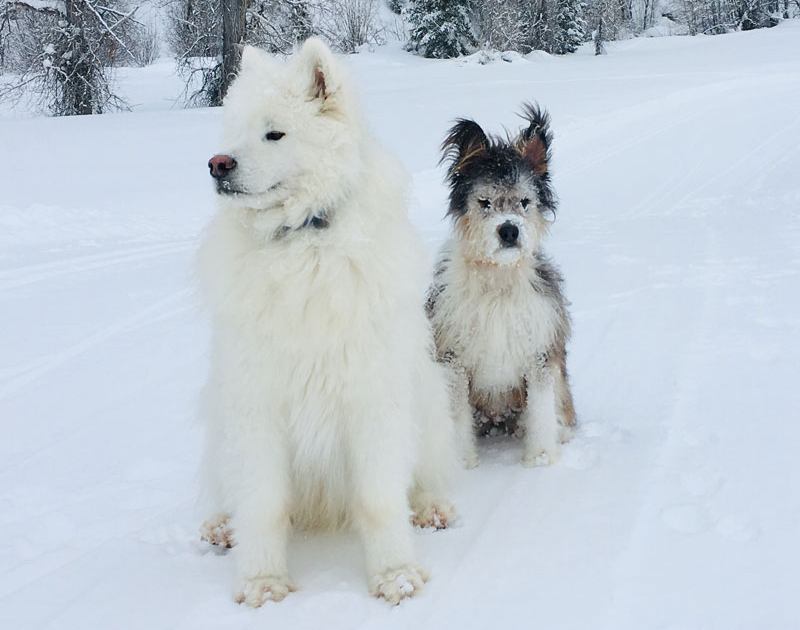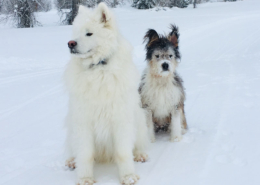Winter Safety Tips
Every dog (and human) is susceptible to the cold. Our mountain region’s weather can quickly fluctuate twenty degrees or more in less than a few hours. Science class taught us that at 32°, liquid changes its state from a liquid to a solid, turning water into ice.
That happens when a dog’s water bowl is left outside, a playful pond turns into an icy trap that can’t support a dog’s weight, and the inside of a freezing car (that acts like a refrigerator) leads to hypothermia or frostbite. Any extreme temperature is dangerous for a dog.
Did you know that at 45°, dogs begin to feel uncomfortable? If your dog is small, old, thin-coated, or sick, it is at a greater chance for hypothermia or frostbite (especially on ears, paws, and tail tips). Puppies, in particular, do not tolerate the cold as well as adult dogs. They have little body fat and cannot regulate their body temperature. Senior or underweight dogs or those battling a medical condition may have difficulty staying warm. No dog should be left in an uninsulated space.
A reminder: If your puppy or dog is shivering, tail tucking, barking or whining, lifting its paws off the ground, and is reluctant to walk, it’s likely too cold.
Although the outdoors is often some of the best enrichment spaces for our dogs, providing endless sources for new smells, textures, sights, and sounds, some dogs love being outdoors regardless of the weather. Winter (and the cold, snow, and ice it brings) pose potential hazards to dogs.
Ensuring your dog’s safety in cold conditions involves several key strategies:
- Shelter indoors: Avoid prolonged outdoor exposure during extreme cold. If your dog primarily lives outdoors, ensure they’re acclimated, have a double coat, access to unfrozen water, and a wind-protected, insulated shelter with a dry, natural material. (Preferably long-stem grass hay, not wheat straw).
- Dress appropriately: For smaller, older, or thin-coated breeds, use a jacket or sweater to prevent frostbite. Don’t trim or cut your dog’s coat; however, strategically clip fur to avoid snow accumulation on the chest and paws.
- Avoid frozen bodies of water: Exercise caution around frozen water bodies to prevent accidents.
- Manage diet and exercise: Adjust your dog’s diet to their activity level.
- Prevent toxin exposure: Be aware of salt, antifreeze (it tastes sweet to dogs), and any other de-icing agent and its effect on paws. Always wipe off your dogs’ paws to remove any harmful chemicals.
- Paw care: Regularly check your dog’s paws to prevent cuts, cracks, or discomfort from ice, snow, and salt. Use Musher’s Balm or train your dog to wear protective booties.
- Car safety: Never leave your dog alone in a cold vehicle. It can quickly become dangerously cold.
- Hydration and nutrition: Cold weather takes a lot out of the body. When the humidity drops in winter, it can cause dehydration. Your dog uses extra energy to stay warm, and they need proper hydration and nutrition for their body to function sufficiently. It is not uncommon for a dog to drink more in cold weather. Also, providing room temperature water as ice-cold water can lower their body temperature.
- Create a cozy bed: A cozy, warm bed with a blanket is the ideal place for your dog to rest, nest, and relax. There’s nothing better than cozying up with your dog if you allow it to cuddle on the bed or sofa with you. We’ll let you decide!
- For outdoor or very athletic dogs: That extra teaspoon of bacon fat or meat dripping can be added to their food. Those drippings have essential fatty acids for skin health; that bit of extra fat becomes an insulator and helps maintain body heat.
If in doubt, check with your local vet!




